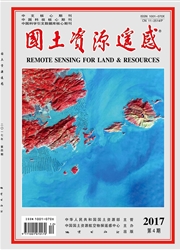

 中文摘要:
中文摘要:
基于2010年Landsat TM/ETM数据,结合Google Earth影像和其他资料,采用面向对象的分类方法,以30 m的分割尺度对图像进行分割,并通过比值指数、归一化差值水体指数及谱间关系等指数来提取水体信息,将水体分为河渠、湖泊及水库坑塘3类,并对分类结果进行精度验证,最终得到中国湖泊空间分布信息;以此为基础,计算出反映湖泊形态的景观指数(如形状指数、近圆形指数及分维数等),并结合湖泊的面积和湖泊岸线长度来说明湖泊的基本状况及其形状的复杂程度。结果表明:利用面向对象分类方法可以得到较高的分类精度,3种类型水体分类的总精度为93%,湖泊分类精度达到90%以上;在中国内陆,面积大于1.0 km2的自然湖泊2 477个,总面积约77 934.72 km2;在5个湖区中,青藏高原湖区的湖泊面积最大,占湖泊总面积的54.34%,其形状指数和分维数均值为最小,湖泊形态比较简单;东部平原湖区降雨充沛,水系发达,其形状指数和分维数均值最大,湖泊岸线更加曲折,形态复杂多变;通过分析得出,形状指数与分维数有明显的相关性(R2=0.95),湖泊岸线分维数值越高,其形状指数越大,岸线越复杂。
 英文摘要:
英文摘要:
Based on 2010 Landsat TM/ETM+ satellite remote sensing imagery data and referring to Google Earth imageries and other historical documents, the authors used object -oriented classification method to extract inland water bodies across China. The authors set imagery segmentation scale at 30 m, and extracted water bodies with ratio index, Normalized Difference Water Index (NDWI) and spectral relation. There are three types of water, i. e. , rivers, lakes, and reservoirs. Finally, the spatial distribution of lakes in China was obtained. Using ArcGIS software package, lake area, shoreline length, shape index (SI), related circumscribing circle (RCC), fractal dimension (FD) and other landscape indices, the authors conducted calculation, and divided China into five lake districts according to previous researches. The differences of lake morphology were comparatively analyzed in the five lake districts. The results show that the object -oriented classification method has better classification accuracy. The overall accuracy of the three types of water is 93%, and the classification accuracy of the lake is over 90%. Statistically, the number of lakes with area greater than 1.0 km2 is 2 477, totaling 77 934.72 km2. The Qinghai -Tibet Plateau Lake District (QTPLD) has the largest lake area, accounting for 54.34% of the total lake area in China. The averages of SI and FD are the minimum, thus the lake morphology is simple in the QTPLD. However, the rainfall is abundant and the water system is well developed in Eastern Plain Lake District (EPLD). Its averages of SI and FD are the maximum among all the sub - lake regions. The lake shoreline is more zigzag, and hence the lake morphology is more complex in the EPLD. In addition, SI and FD have significant correlation (R2 = 0.95). The higher the FD of the lake, the greater the observed SI.
 同期刊论文项目
同期刊论文项目
 同项目期刊论文
同项目期刊论文
 History of fuel consumption inferred from polycyclic aromatic hydrocarbons in sediments from the sou
History of fuel consumption inferred from polycyclic aromatic hydrocarbons in sediments from the sou Evaluation of risk associated with organchlorine pesticide contaminated sediment of the Lake Lianhua
Evaluation of risk associated with organchlorine pesticide contaminated sediment of the Lake Lianhua Estimation of water consumption and productivity for rice through integrating remote sensing and cen
Estimation of water consumption and productivity for rice through integrating remote sensing and cen Evapotranspiration Estimation Based on MODIS Products and Surface Energy Balance Algorithms for Land
Evapotranspiration Estimation Based on MODIS Products and Surface Energy Balance Algorithms for Land The Effect of Urban Expansion on Urban Surface Temperature in Shenyang, China: an Analysis with Land
The Effect of Urban Expansion on Urban Surface Temperature in Shenyang, China: an Analysis with Land The use of single-date MODIS imagery for estimating large-scale urban impervious surface fraction wi
The use of single-date MODIS imagery for estimating large-scale urban impervious surface fraction wi Remote sensing of chlorophyll-a concentration for drinking water source using genetic algorithms (GA
Remote sensing of chlorophyll-a concentration for drinking water source using genetic algorithms (GA Application of SEBAL for rice water consumption and productivity estimation through integrating remo
Application of SEBAL for rice water consumption and productivity estimation through integrating remo Relationship between polycyclic aromatic hydrocarbons (PAHs) and particle size in dated core sedimen
Relationship between polycyclic aromatic hydrocarbons (PAHs) and particle size in dated core sedimen Impact of land use and land cover dynamics on Zhalong wetland reserve ecosystem, Heilongjiang Provin
Impact of land use and land cover dynamics on Zhalong wetland reserve ecosystem, Heilongjiang Provin Sol-solvothermal preparation and characterization of (Yb, N)-codoped anatase-TiO2 nano-photocatalyst
Sol-solvothermal preparation and characterization of (Yb, N)-codoped anatase-TiO2 nano-photocatalyst 期刊信息
期刊信息
